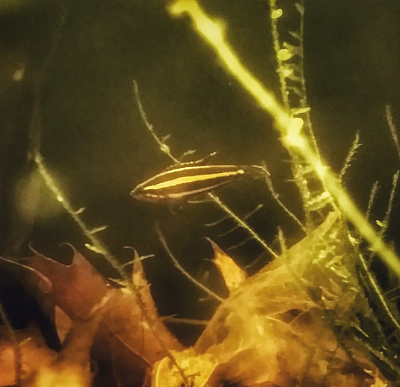The Parosphromenus Genetic Resource Center is dedicated to the genetic conservation, captive propagation, and public distribution of the Parosphromenus genus within the United States Email us at: [email protected]
Who we are
A U.S.-based initiative for the living conservation of a vanishing genus
Since 2020, the PGRC has actively supported the conservation of Parosphromenus species within the United States. Through focused, small-scale breeding efforts, we have distributed over 200 in-house bred fish to conservation-minded aquarists across the country, establishing the early foundations of a national living network dedicated to preserving the genetic diversity of this remarkable genus.
While conservation-hobbyists in Europe and Asia have long led the way, we believe the U.S. is now poised to contribute meaningfully to the global, grassroots effort to ensure that Parosphromenus, whose habitats are disappearing rapidly from Southeast Asia’s lowland rainforests, do not vanish from the earth altogether.
Whether you’re new to blackwater fish or already keep licorice gouramis, we invite you to explore, connect, and consider joining the living preservation movement.
Welcome to the Parosphromenus Genetic Resource Center (PGRC)
At the PGRC, we are passionate about preserving the incredible genetic diversity of Parosphromenus—a genus of stunningly beautiful and critically threatened freshwater fish. Our mission is simple but urgent: to secure the future of these rare species through ethical breeding, collaborative stewardship, and public engagement.
What We Do
We begin at the source: by obtaining collection-location-confirmed Parosphromenus species from reliable, ethical channels. Each fish we bring in has a traceable, verified origin, allowing us to preserve the unique genetics of wild populations—something no generic trade stock can provide.
In our care, these fish are bred to the highest standards of genetic integrity. We focus on maintaining healthy, robust populations that reflect their wild counterparts as closely as possible—no hybridization, no guesswork, just faithful stewardship.
Sharing the Stewardship
Once established, we freely distribute genetically sound pairs to hobbyists across the United States. You pay only for shipping—because we believe that true conservation happens through community, not commerce. Our goal is to see thriving, well-documented Parosphromenus lines kept by a wide network of dedicated individuals, ensuring that no single keeper or facility is a point of failure for a species’ future.
A Hub for Everyone
Whether you're a seasoned Paro keeper or curious about trying your first pair, the PGRC is here to support you. We help hobbyists find fish, place excess fry, and share best practices. We want every keeper to feel connected, informed, and empowered.
Serious Conservation Through Hobby Keeping
We don’t just breed fish—we build living insurance populations. Our fish are more than ornamental; they are a safeguard against extinction. As wild habitats disappear at an alarming rate, we aim to offer a meaningful conservation solution, one tank at a time.
Looking Ahead
We’re building trusted partnerships with ethical collectors in Indonesia and Malaysia, working to set new standards in sustainable harvesting and humane handling. Our goal is to ensure that every fish collected for conservation-based export arrives healthy, hearty, and ready to thrive in the hands of dedicated stewards across the globe.
Our approach
Traditionally, the definition of species has stated that “A biological species is a group of organisms that can reproduce with one another in nature and produce fertile offspring.”
This definition, when applied to the Parosphromenus genus, is somewhat problematic, in that many of the phenotypically (and/or geographically) distinct populations of these fish can interbreed.
Since the genus' first scientific description in 1859, the efforts of dedicated taxonomy professionals have described 21 distinct forms within the wider Parosphromenus genus, and there are several other phenotypically distinct forms that remain undescribed in the scientific literature.
The habitats of many of the distinct forms are separated by obstacles which prevent genetic intermingling between local populations, and so speciation (the population-level adaptation to a specific local environment) is happening across, and within, the distinct forms continually.
This species-fluidity adds to the complexity of preserving the genetic uniqueness of this genus.
In terms of the conservation effort, this is further complicated by the fact that many commercially imported Parosphromenus do not have a collection-location specified, and are often only identified as “Parosphromenus dessenari” (the species name of the first scientifically described Parosphromenus population).
The mission:
With this information as background, and for the purposes of the genetic conservation of this genus, the most conservative approach is, therefore, to attempt to maintain separate captive populations by their collection-location. This method does have the potential to unnecessarily separate genetically grouped populations, but it has the advantage of not (accidently) unnaturally interbreeding local populations that would not have interacted in the wild habitats.
The model:
Until and unless an economical method for positive genetic identification of the different forms becomes available, the PGRC will continue to maintain lines of broodstock based on known collection-location (and where collection location information was not available, these lines are maintained separately from other fish, even if they are presumed to be of the same species), and will not interbreed lines of fish from different collection-locations (even if they are phenotypically identical).
Since we strive to preserve the genetic uniqueness of each local strain, our fish are identified via a polynomial nomenclature system, in the following form: Genus, species (presumed, if available), collection-location (when known), collection year (eg. P. linkei, Palangkaraya, '20, or P. “sentang”, '20).

